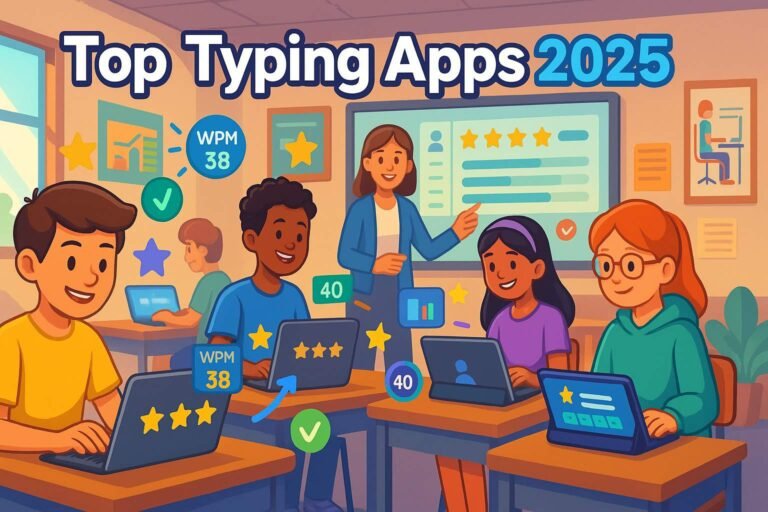Typing Practice Habits That Actually Work for Students in 2025
Typing is no longer just a useful skill; it’s an essential one. In today’s digital classrooms, where speed and accuracy are both valued, developing the right typing practice habits is critical for students. This guide will explore the most effective typing practice habits that genuinely help students in 2025, with a special focus on how technology like the latest wearable technology is influencing learning.
Table of Contents
Why Typing Practice Habits Matter in 2025
With remote learning, virtual exams, and online collaboration becoming the norm, students need more than basic typing skills. Forming healthy and consistent typing practice habits leads to:
- Faster typing speed
- Higher accuracy
- Improved digital literacy
- Enhanced academic performance
Best Typing Practice Habits for Students
1. Set Clear, Achievable Goals Setting short-term and long-term typing goals is key. Whether it’s typing 40 WPM or reducing typos to less than 2%, having a clear target keeps students focused.
2. Practice Daily, Not Occasionally Typing is like playing a musical instrument – you improve with consistency. Encourage students to type at least 15-30 minutes every day. Short, regular practice builds muscle memory and reinforces technique.
3. Use Gamified Typing Tools Platforms like Nitro Type and TypingClub add an element of fun to practice. These tools offer:
- WPM challenges
- Real-time leaderboards
- Personalized progress tracking
4. Focus on Posture and Ergonomics Good posture leads to better typing efficiency and fewer physical issues. Ensure:
- Wrists are neutral
- Back is straight
- Eyes are level with the screen
5. Prioritize Accuracy Before Speed Speed will come naturally with time. Accuracy is more important in the beginning. Practicing slowly and correctly forms strong habits.
6. Leverage Wearable Technology The latest wearable technology is making its way into classrooms. Smartwatches and typing-friendly wearables can:
- Track finger movement
- Monitor sitting posture
- Remind users to take typing breaks
7. Use the Right Keyboard Layout While QWERTY is standard, some students may benefit from exploring Dvorak or Colemak layouts for comfort and speed.
Typing Practice Habits for Different Age Groups
Elementary Students:
- Use colorful interfaces and rewards-based learning
- Focus on home-row key familiarity
- Practice with interactive stories and typing games
Middle School Students:
- Emphasize accuracy
- Introduce WPM tracking
- Use wearable reminders to maintain posture
High School & College Students:
- Incorporate professional typing software
- Build typing into academic tasks (e.g., essays, coding, reports)
- Introduce alternative layouts if needed
How to Track Typing Progress
Consistent monitoring encourages improvement. Recommended tools:
- Nitro Type for gamified competitions
- Typing.com for skill-level quizzes
- Keybr.com for advanced tracking and accuracy focus
Incorporating Typing Habits into School Curriculum
Typing shouldn’t be an afterthought. Schools can:
- Allocate 15 mins per day to typing sessions
- Use wearable tech to monitor practice quality
- Reward top performers with certificates or badges
The Future of Typing Practice with Wearables
Expect AI-powered wearables that can:
- Give real-time feedback on typing rhythm
- Adapt lessons to student behavior
- Detect fatigue and recommend breaks
The integration of wearable technology into education will personalize and optimize how students form and maintain typing practice habits.
If you’re looking for tools that make practicing more fun and effective, check out our guide on gamified typing tools. It’s a great way to stay consistent with your typing practice habits.
Final Thoughts on Building Consistent Typing Practice Habits
Establishing successful typing practice habits doesn’t mean spending hours in front of a screen. Even 15–20 minutes of focused typing per day can lead to significant improvement over time. The key is consistency. Whether you’re using games, structured lessons, or simple transcription exercises, staying on track with your routine makes a big difference.
Teachers and parents should also encourage students to track their progress using typing tools like Nitro Type or TypingClub. This reinforces motivation while helping learners visualize their growth in both typing speed and accuracy.
Additionally, keeping the learning environment distraction-free, using the right posture, and mastering touch typing techniques can strengthen these habits further. In 2025 and beyond, these strategies are more important than ever with the rise of remote learning and digital classrooms.

Hi, I’m Kamran Khatri, the author behind NitroType.blog. I share typing speed tips, Nitro Type updates, gaming tricks, and productivity hacks to help you type faster and smarter. My goal is to make typing fun while helping you improve your skills like a pro. If you’re passionate about typing or want to level up your Nitro Type game, you’re in the right place!







